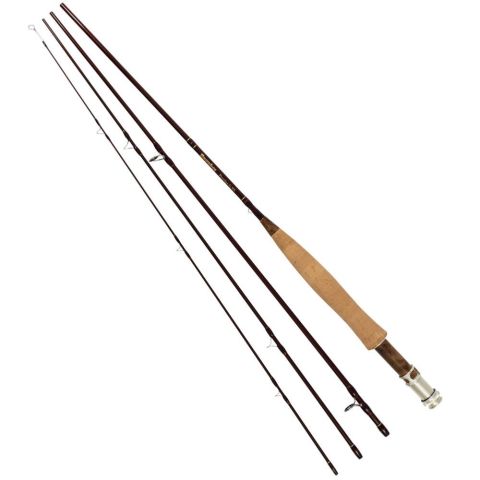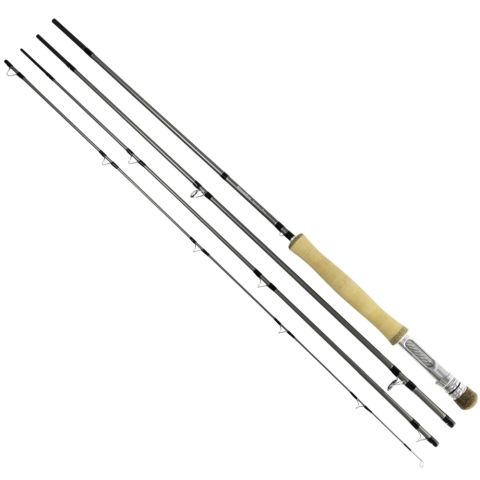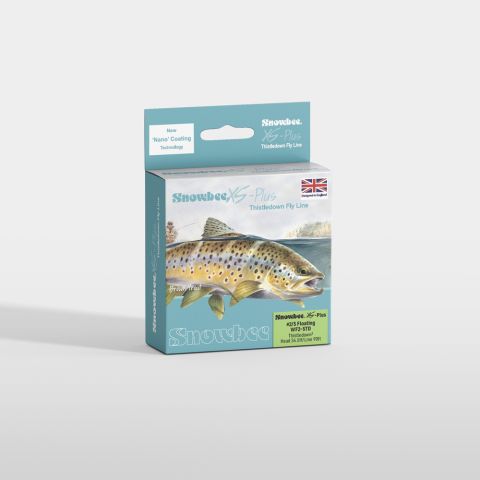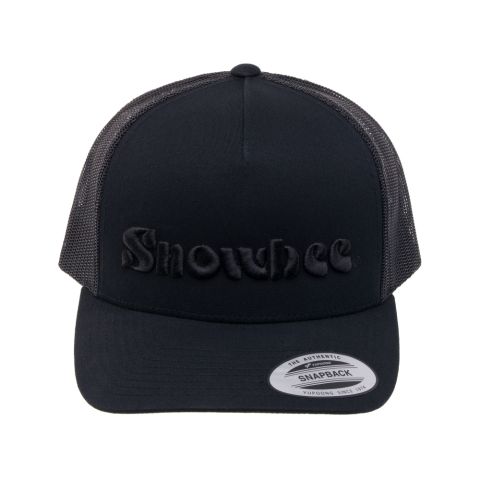A prep, practice and competition report by England Team member James Atkinson.
As with every World Championship I’ve competed in, it always seems to arrive sooner than expected. Despite 10 months since the 2024 World Championships in France concluded, it still felt like there wasn’t quite enough time to prepare.
This year’s competition was held in the South Bohemian district of Czech Republic across five venues. These were: Lipno Lake; the Otava River; and three distinct sections of the Vltava River – each separated by vast hydro dams. There was also a reserve session to be fished from the bank of a lake.
With so many different environments to prepare for, my kit list was immensely long. Fifteen rods, around 25 reels and spools, plus all the terminal tackle; flies, tippet, wading gear, fly-tying materials an more. All of which – plus clothes – had to squeeze into two 22kg bags. Almost impossible.
My 'serious' prep tends to kick in about three weeks beforehand. This involves a frenzy of fly tying as expected. Plus leader construction, gear checks, and reel cleaning too, ensuring everything is flawless by the time we arrive.
Getting there
On the morning of 17 June, our team met at Manchester Airport, buzzing with anticipation. Our flight took us via Munich to Prague, where, thankfully, baggage collection was more efficient than we’d feared. Bags collected, we loaded up for the three-hour drive to our base for the trip: the Wellness Hotel in Frymburk.
After 15 hours of travel, we arrived around 10:30 pm, still needing to check-in, unpack and set up tackle for the next day.
Practice waters
Practice is limited for all teams and can get very busy, so beating the crowds is essential. Despite working into the early hours, we were all up and out by 6:45am the next morning.
The goal in these sessions isn’t to catch loads of fish, but to learn. What flies are working? What weights? What colours? What’s the river telling you? England Team practice is always done in pairs; we cover more ground and can swap tactics in real-time.
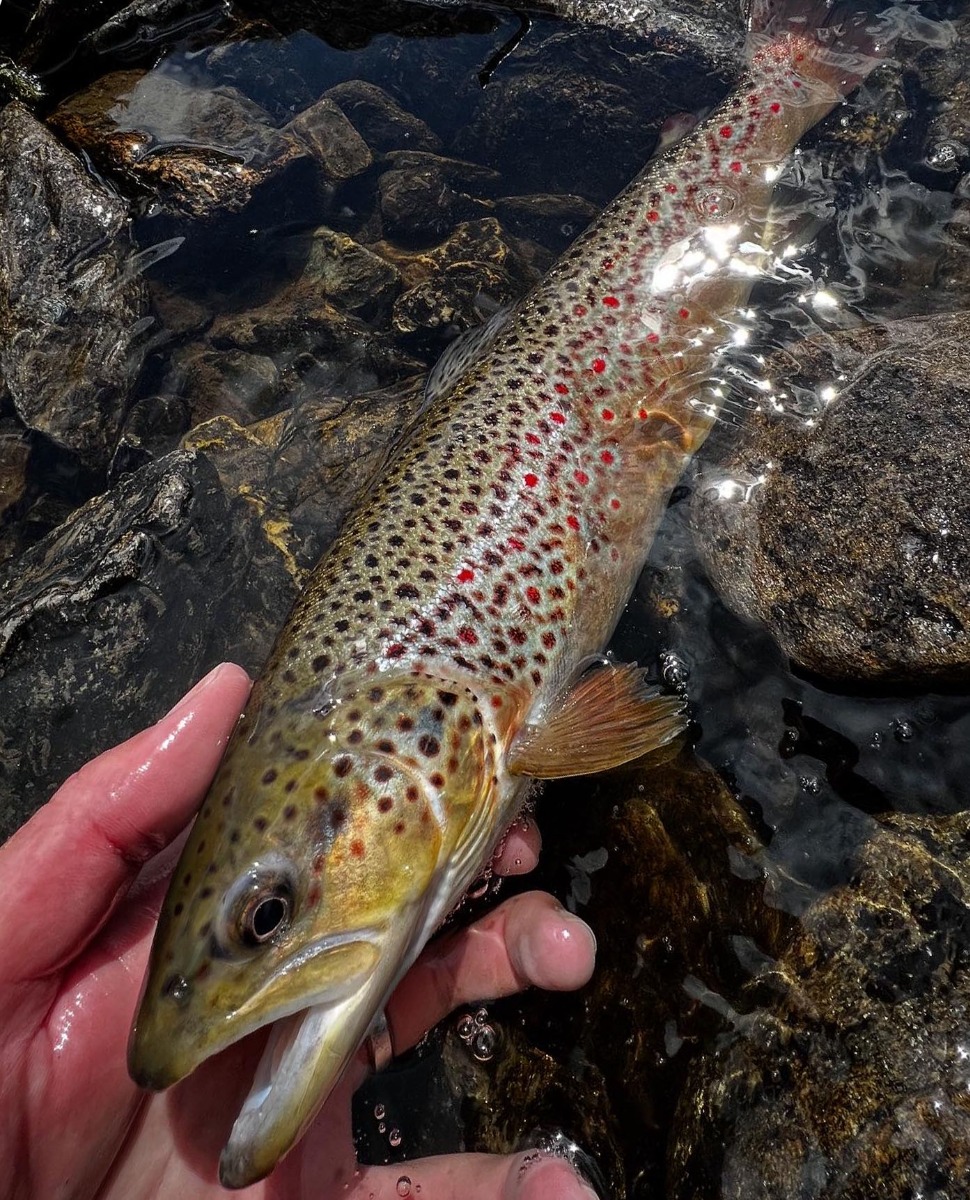
Our first stop was the Vltava at Rožmberk, fishing the section below the weir. My partner for the day was Scott Nellins, a seasoned international angler with plenty of experience in Czech Republic.
I started fishing streamers using my Spectre Pro 10ft #6 rod, paired with a CD4 line. My set-up was simple: white tadpole with a silver bead and black tadpole with an orange bead. Three casts in, I hooked a 30cm stocked rainbow. Working a steady run, I picked up several more, mostly on the black pattern. A great start.
Switching to a double-nymph rig, I explored a good-looking pool and landed a couple more fish. Not nearly as many as I would have expected. Scott, on the other hand, was catching coarse fish and some stockies on nymphs, helping us build a clearer picture of what might work.
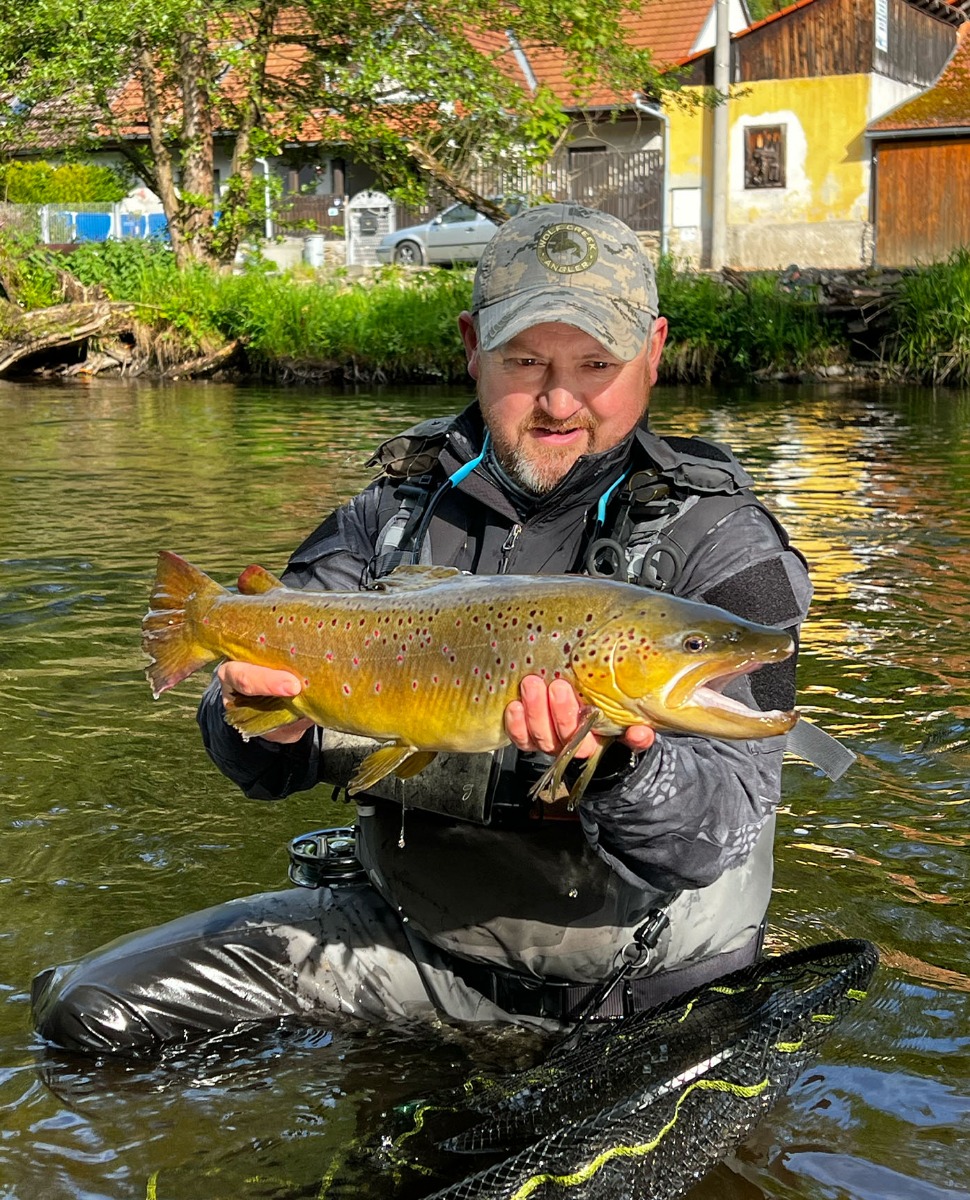
Captain Howard Croston with a fantastic brown trout during practice
After lunch and a debrief with the team, we refined our tactics further and fished into the afternoon. As the temperature rose and insects hatched prolifically, the fishing lit up. At one point, I caught 13 fish without moving my feet. Another run yielded 11 fish in 10 casts, almost all on nymphs or duo set-ups.
The competition sessions would be held from 8am to noon to avoid the swarms of tourist rafts. This aftenoon practice still gave us valuable insight into what the fish would feed on and what would trigger them to feed.
The next day, we fished half a mile downstream from our previous spot, starting early to mimic competition timings. The fishing was tougher here, reminding us how ‘peggy’ this championship might be.
While the trout were sparse, we found success close to the banks, targeting chub, roach and silver chub. All species we rarely fish for with the fly in the UK. These fish require precision. Flies must land tight to the edge, and contact with them needed to be immediate otherwise their gentle bites are missed.
Despite being end of May, the weather was unusually cool and wet, with highs of around 16°C. Far from the typical Czech summer. We had barely seen a single rising fish during practice hours, presumably due to the low temperatures. At midday, the heavens opened, so we packed up and drove to scout the competition sections.
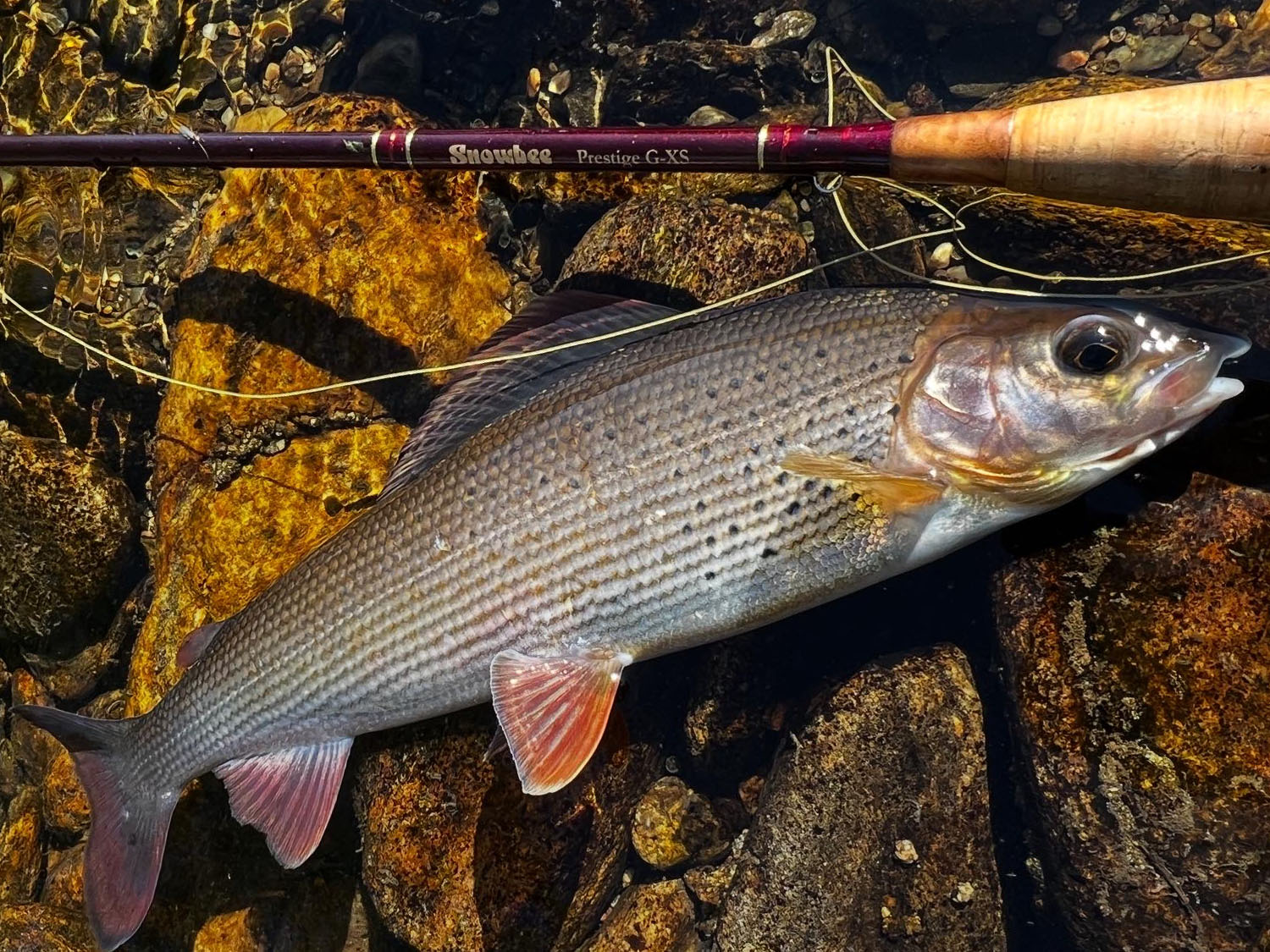
One of the grayling I caught on our practice day on the Otava river
The rest of the week followed a steady rhythm: early starts, lots of fly changes, constant observations. We were catching a wide mix of fish, stocked brook trout, wild brown trout, and various white fish.
One day, we joined Katka Svagrová from the Czech Women’s Team for a session. Katka, a veteran of many championships, shared some valuable insights and confirmed much of what we’d already learned. She also offered a few new tweaks to our approach.
A well earned rest
On Saturday, the day before the opening ceremony, we took a much-needed break. We had solid plans in place, and instead of risking a burnout, we used the time to tie the last of our flies, re-check gear and rest.
I tied around 300 flies over the course of the week to cover every possible situation. Rods were marked, lines cleaned, leaders tied – nothing left to chance. In past years, I’ve found myself tying flies late into the night between sessions – not ideal when you’re already exhausted. This time, I was ready. The most prepared I’ve ever felt before a competition.
Opening ceremony
On Sunday the opening ceremony was held. Dressed in our England blazers, we proudly paraded through town with teams from all over the world, soaking in the atmosphere. There were traditional performances, speeches from officials, and finally, the formal declaration. The 2025 World Fly Fishing Championships were now open.
The championship diary
Day 1: Vyšší Brod, Vltava River – Peg 4
Drawn in Group 3, I began my campaign on the middle section of the Vltava at Vyšší Brod. This was the only un-stocked section in the entire competition. Fishing for wild trout, unlike the heavily stocked venues we’d focused on during practice, was always going to feel unknown. I was quietly optimistic with my peg – rumoured to be one of the better ones in this section.
The peg had a bit of everything – small pockets at the tail, a long middle run, a decent riffle, and some tempting eddies along the far bank.
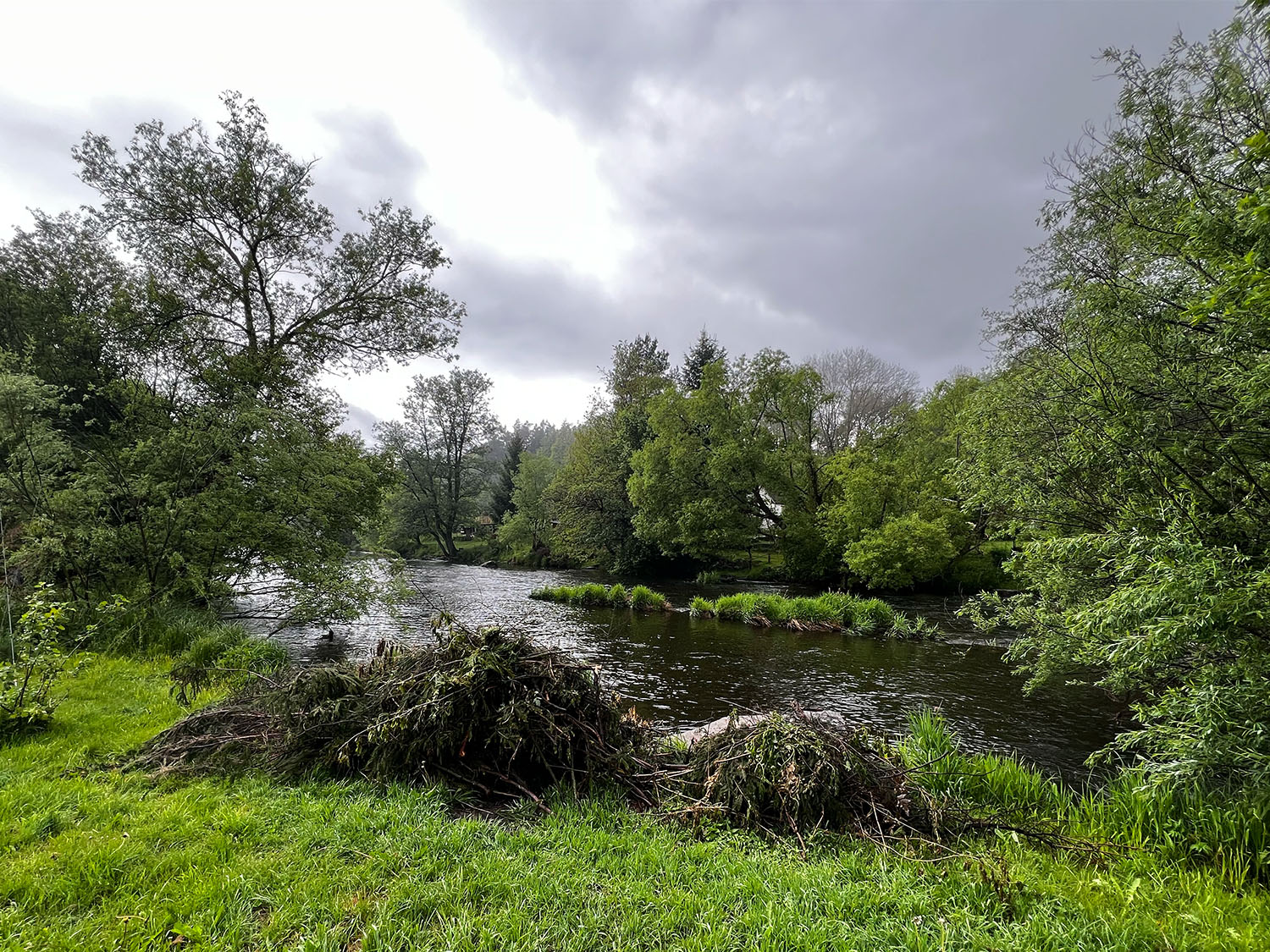
The middle section of my peg at Vysai Brod
England Team manager Mark joined me on the bank for support. Right away, we spotted fish rising at the bottom of the beat. Thus, I had to start on dries.
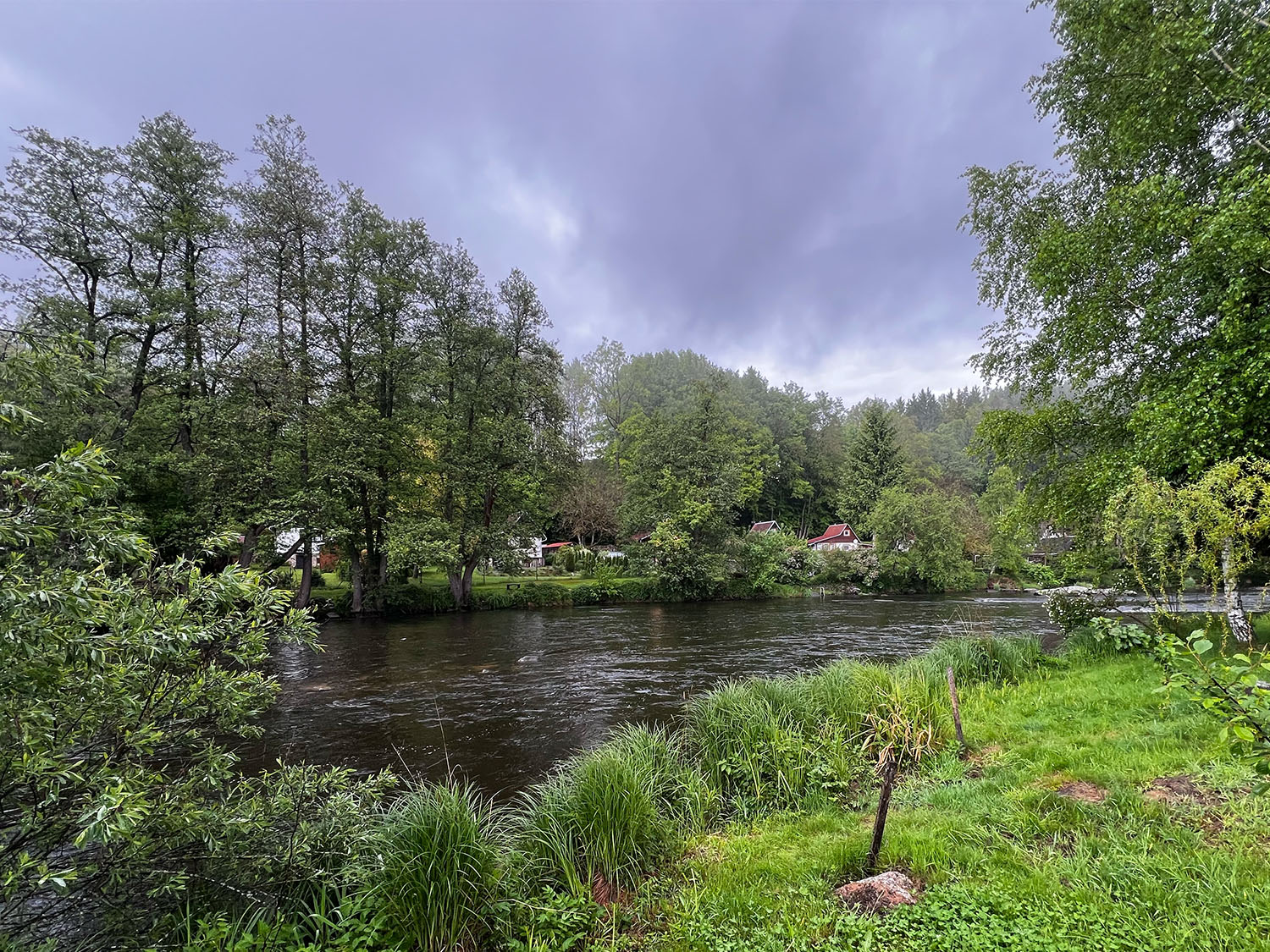
The tail of the main run where the fish were rising
My heart raced with anticipation. Just five casts in, a head broke the surface over my caddis imitation – fish on! It ran straight into streamer weed and came off though. A quick change to stronger 0.12mm tippet gave me confidence to push on, and I caught steadily for the next ten minutes.
When takes slowed, I swapped to a dry fly with a different profile. I started catching again and pushed my total to 15 fish in the first 90 minutes.
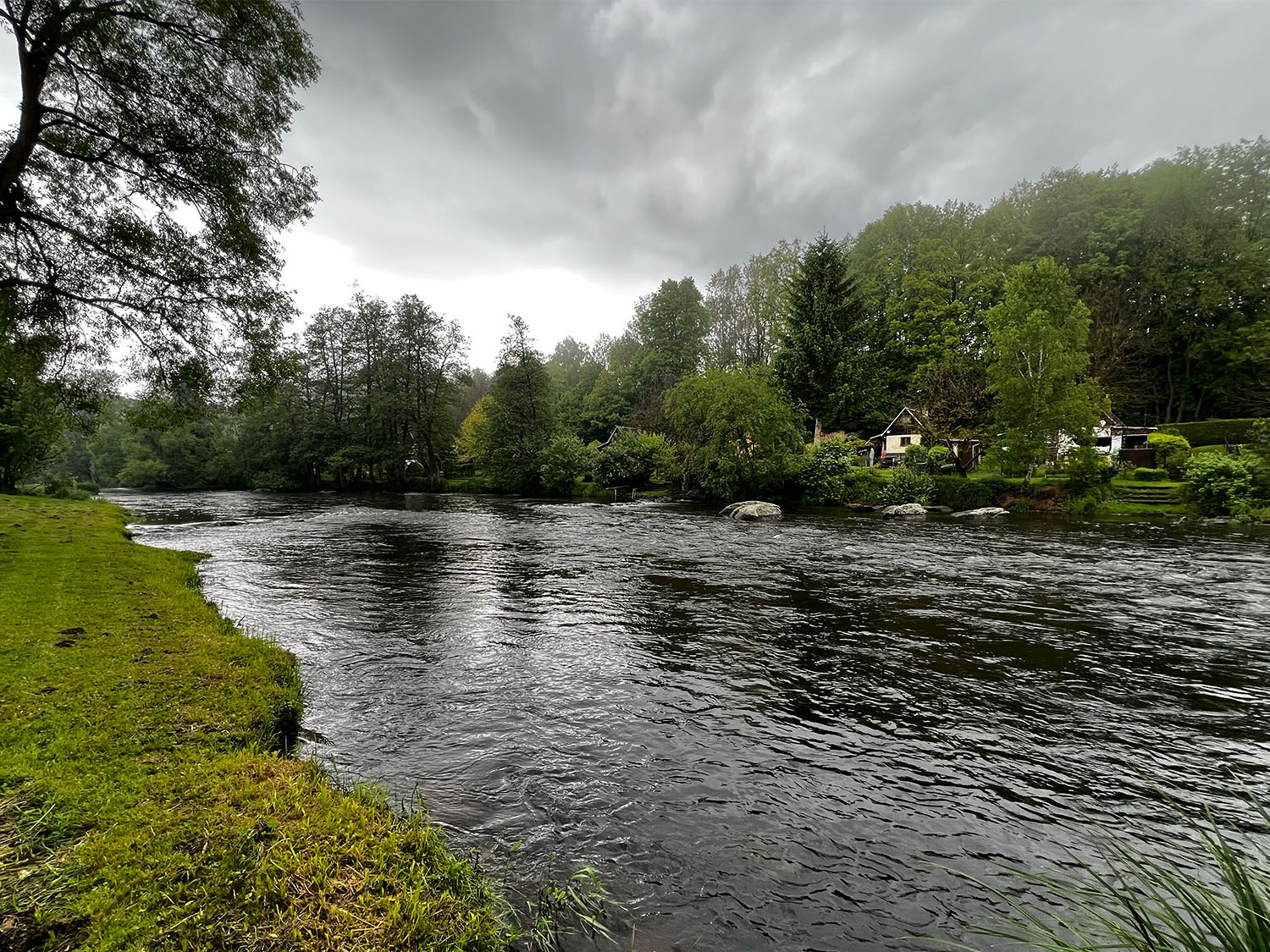
The fast shallow riffle below the main run with eddies on the far bank behind the rocks
As the water levels dropped – thanks to the upstream hydro dam – the rises faded. I switched tactics.
Nymphing the fast water below yielded nothing. Next, I tried dry-dropper, which brought a few fish, including two on a second pass of the upper riffle. Sometimes, fishing the same water from a different angle can yield more fish.
I continued to pick pockets methodically, catching in spurts. Time was ticking.
In the final half-hour, I returned to the tail where fish had risen earlier. Three takes from three casts, but only one made the net. A final push with the dry-dropper in the shallows brought two more. My final tally: 25.
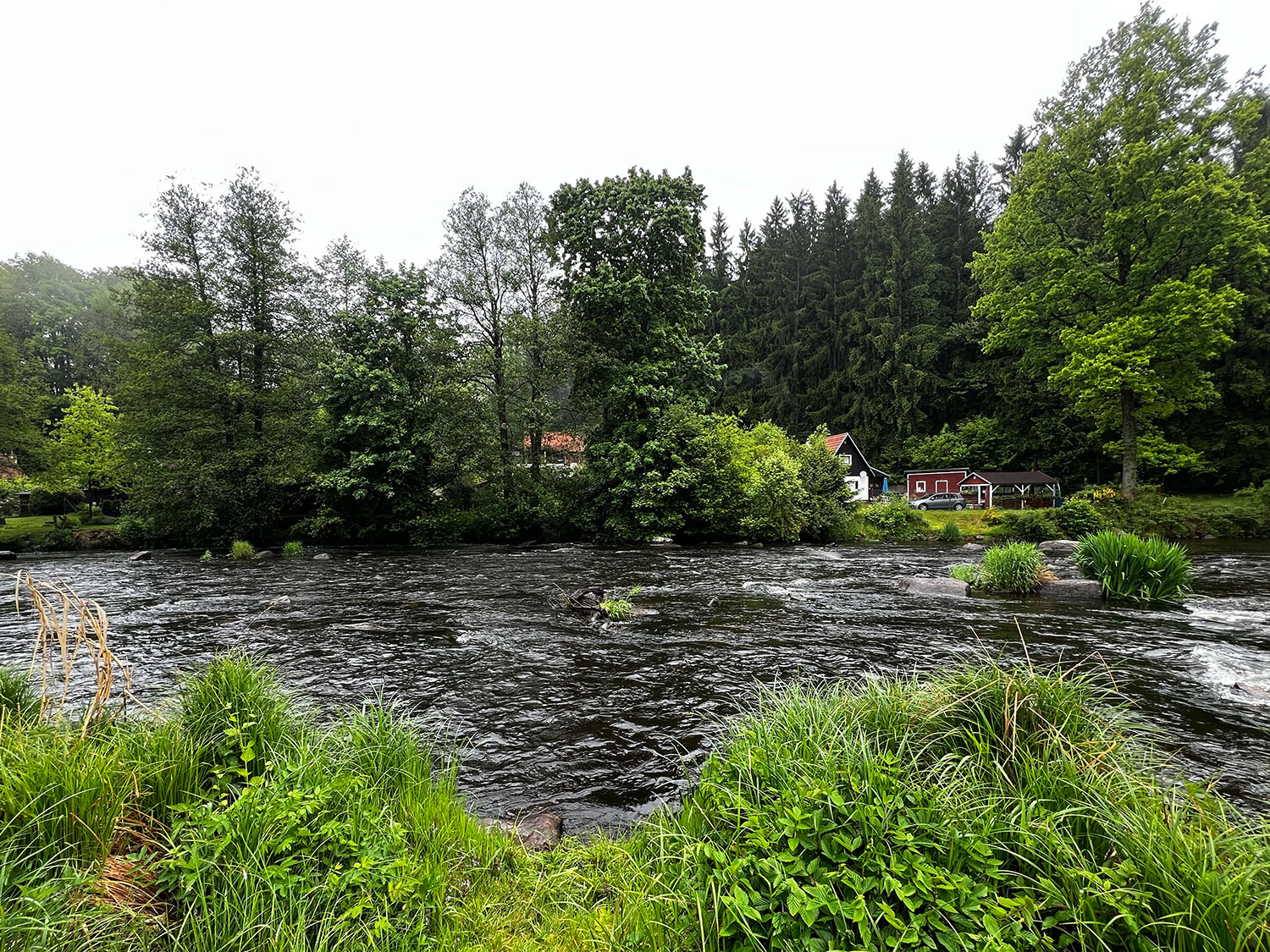
The pockets at the bottom of my peg
Waiting for vehicles, nervously, I asked Jack Arnot from Team USA how he’d done: 26. Then I heard the angler above me had 32. My heart sank.
However, fly fishing can surprise you, my larger average fish length actually gave me 2nd place in the session. An excellent start. The rest of the team performed well, and we ended Day 1 sitting in 3rd place.
Elated from Day 1 and knowing we were in medal contention, nerves were running high on the bus to Rožmberk. The peg draw can feel agonising. When peg 25 was called for me, I checked the numbers. Nineteen fish had come off it the day before, resulting in 10th for the session. Not the best, but workable.
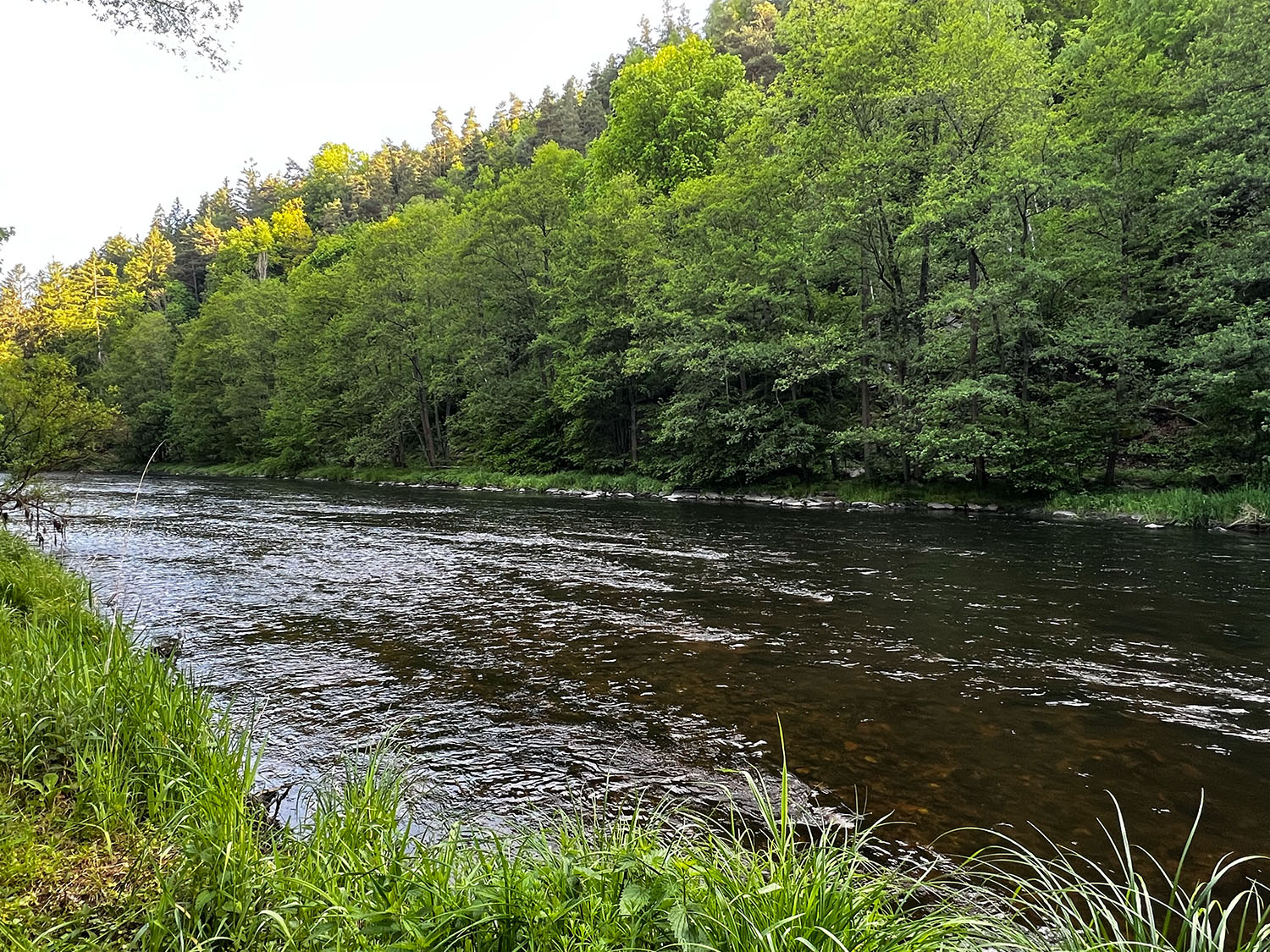
The bottom half of my peg, just as the pool tailed out into the riffles
The peg featured a deep hole at the bottom and a decent mid-beat riffle. Good water for holding stocked fish. I started with a DI3 line and two flies. A white streamer with green bead on the dropper and a black tadpole with an orange bead on the point. My best colours in practice.
The deep hole gave up nothing at first. I waded in, casting across and down, chest-deep in the cold water. As worry started to set in, the line went tight. Not one, but two fish on! One popped off quickly, leaving me to land the other. Relief.
I settled in, picking up fish steadily. One surprise was a 3lb barbel that I thought was the bottom until it started moving in the current.
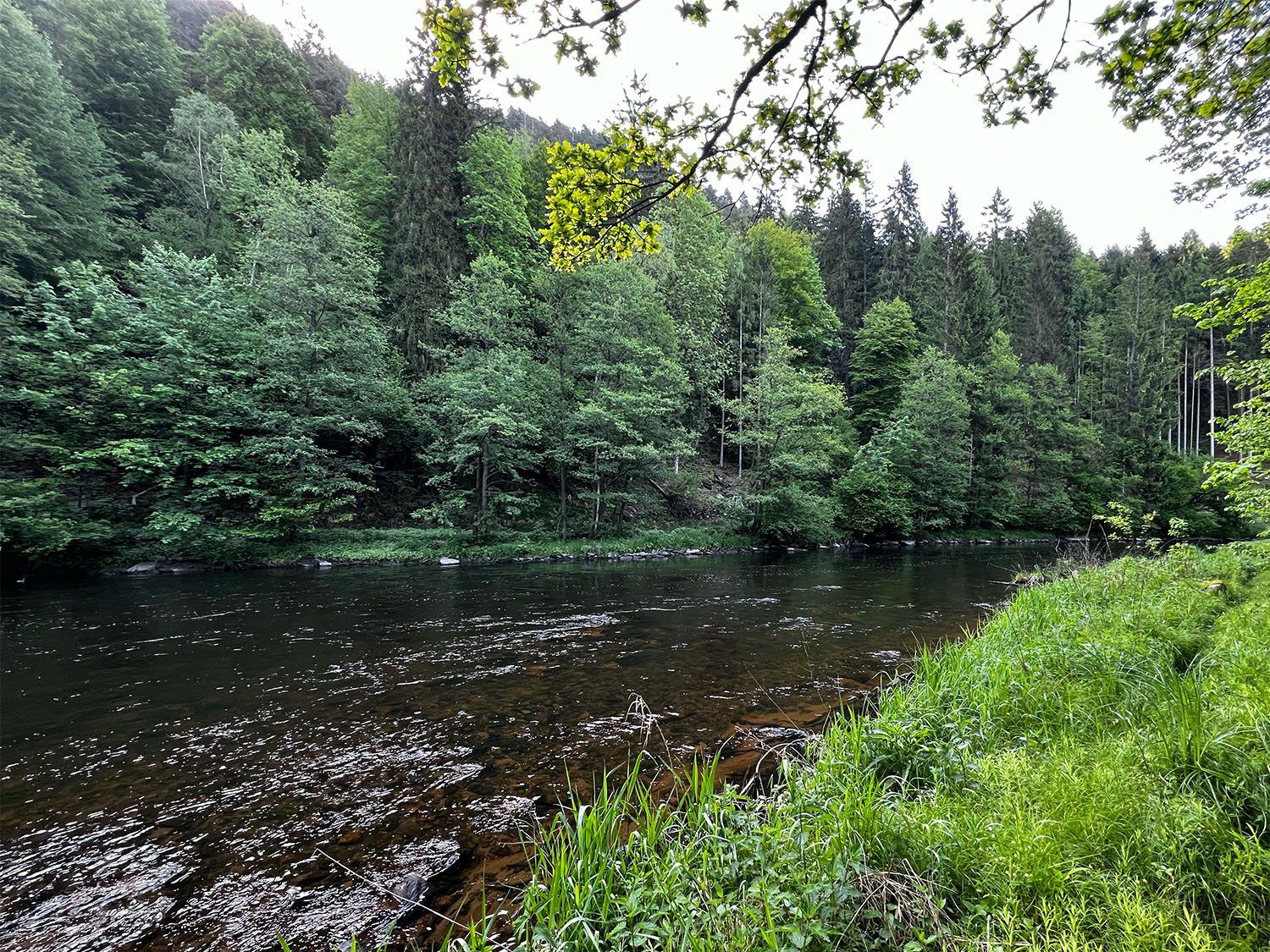
Looking upstream into the deep pool and the top of my peg
Raft traffic was picking up, disrupting the water and my casting. Mark was again bankside, shouting guidance between flotillas. Sometimes I even hooked fish beneath rafts – chaotic but productive.
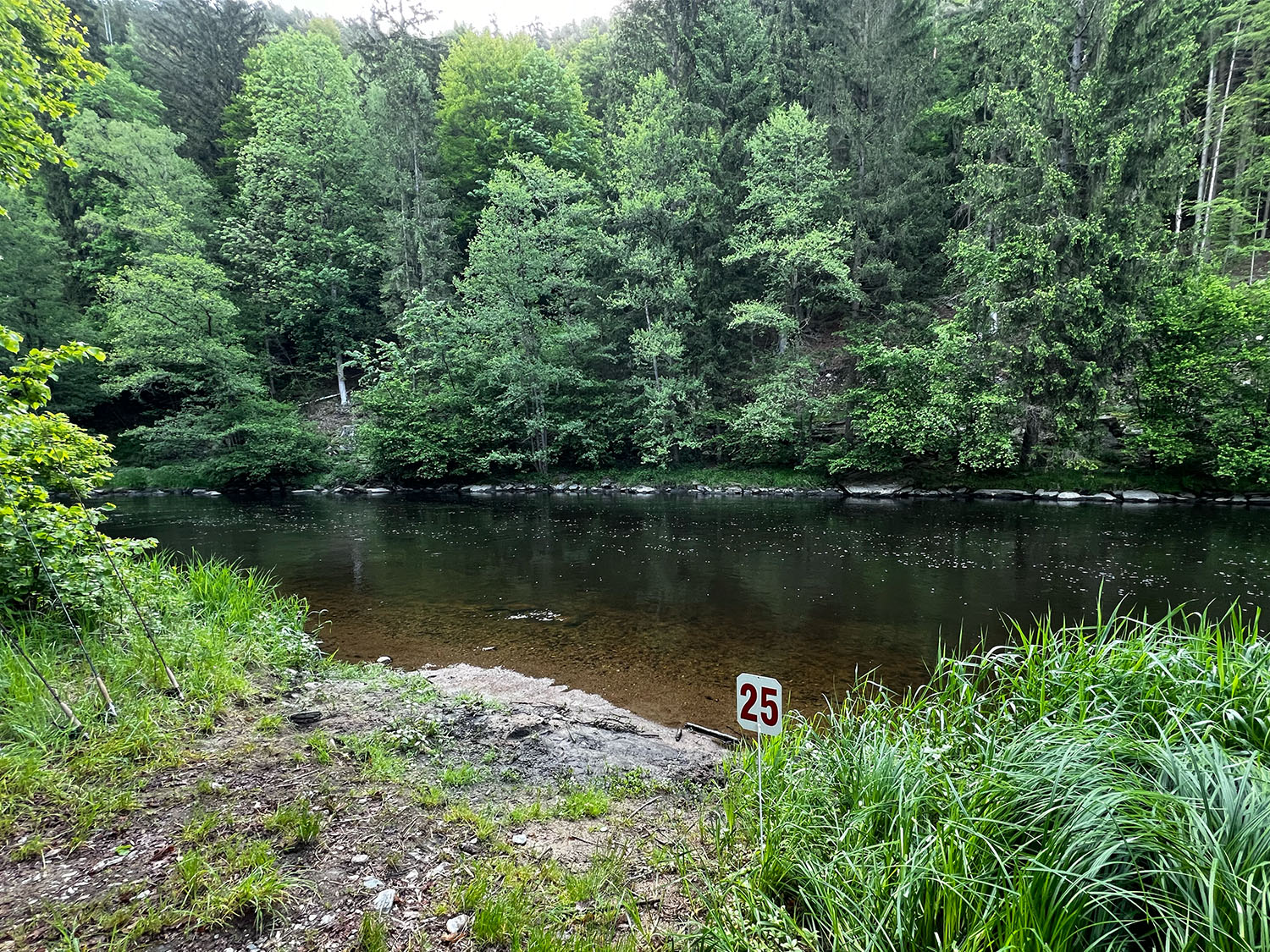
The top of my peg
With 20 minutes to go, I had landed 28 fish. I had a decision to make: rework the same water or target chub under the tree-lined far bank. I opted to re-fish the productive areas, changing to a more natural-looking streamer combo: olive and black with a copper bead. This proved spot-on, with four more fish, including one on the final cast.
That last fish was my favourite of the whole championship. Just after the one-minute call, a fish rose well upstream. I fired my back cast over it, stripped quickly and it exploded out of the water—fish on! We get five minutes’ grace to land a fish at the buzzer, and I made it count.
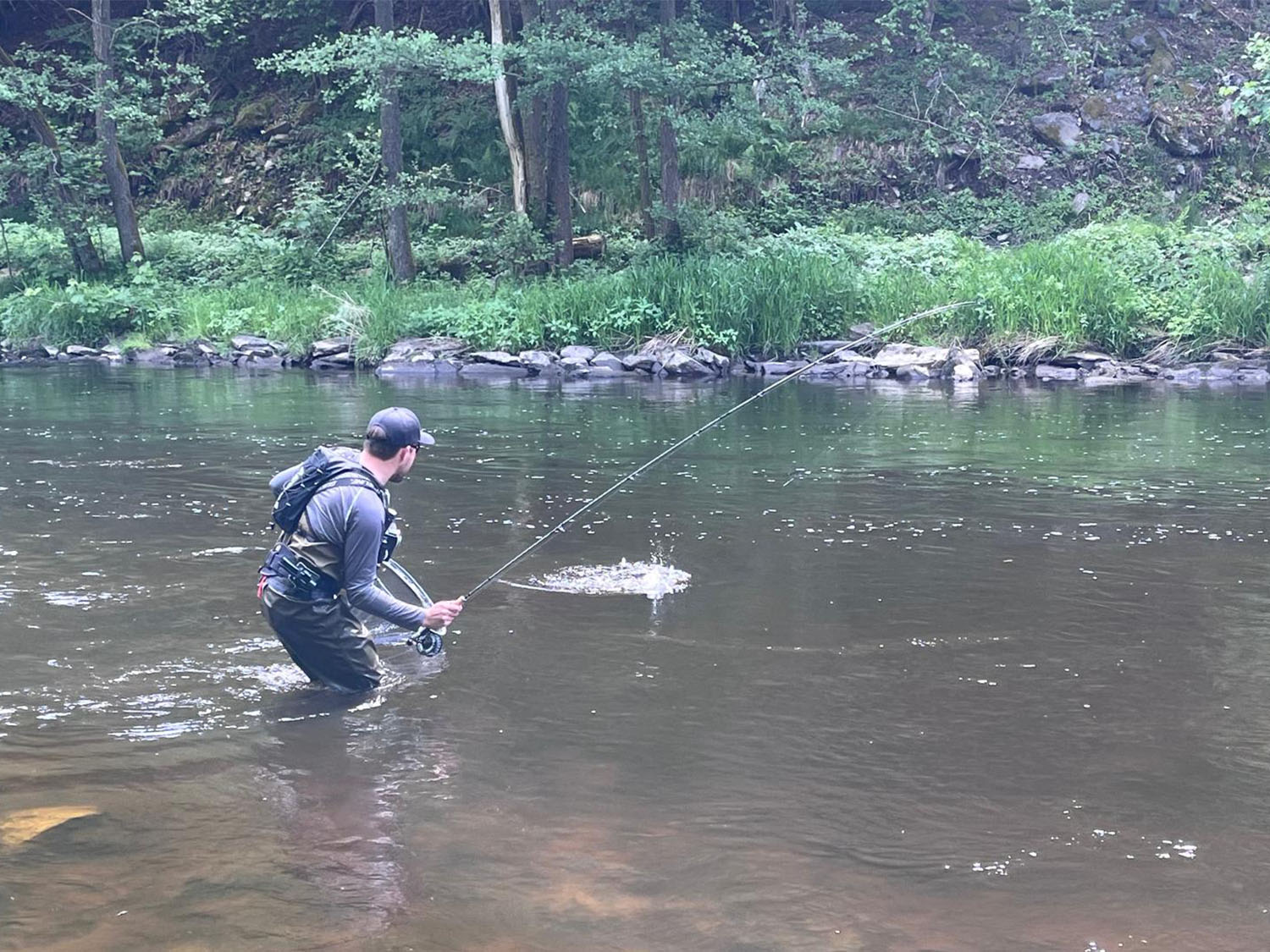
My 10ft 6wt Spectre pro playing the large stock fish well
Final tally: 32 fish. Giving me 3rd place in the session. The team remained in bronze medal position.
Day 3: Otava River – Peg 15
The Otava had not been kind to us. Brian did okay on a low beat, and Scott pulled out eight fish from what was essentially a canal! But now the weather had turned. Cold wind and rain killed off any surface activity.
The draw was done en-route again. I couldn't hear the draw so I had to ask Sean Jones from Wales who was right next to the sector judge, “14, mate” he said. Relief! A good peg.
Not quite. There was a mix-up – I actually drew peg 15. A beat that had fished poorly so far; whilst peg 14 was stockie heaven.
My water was crystal-clear and shallow. No depth, no cover, and hardly any features. The one promising area was a shallow run under a bridge. I planned to fish it carefully, then cover the margins with dries, and search the flats.
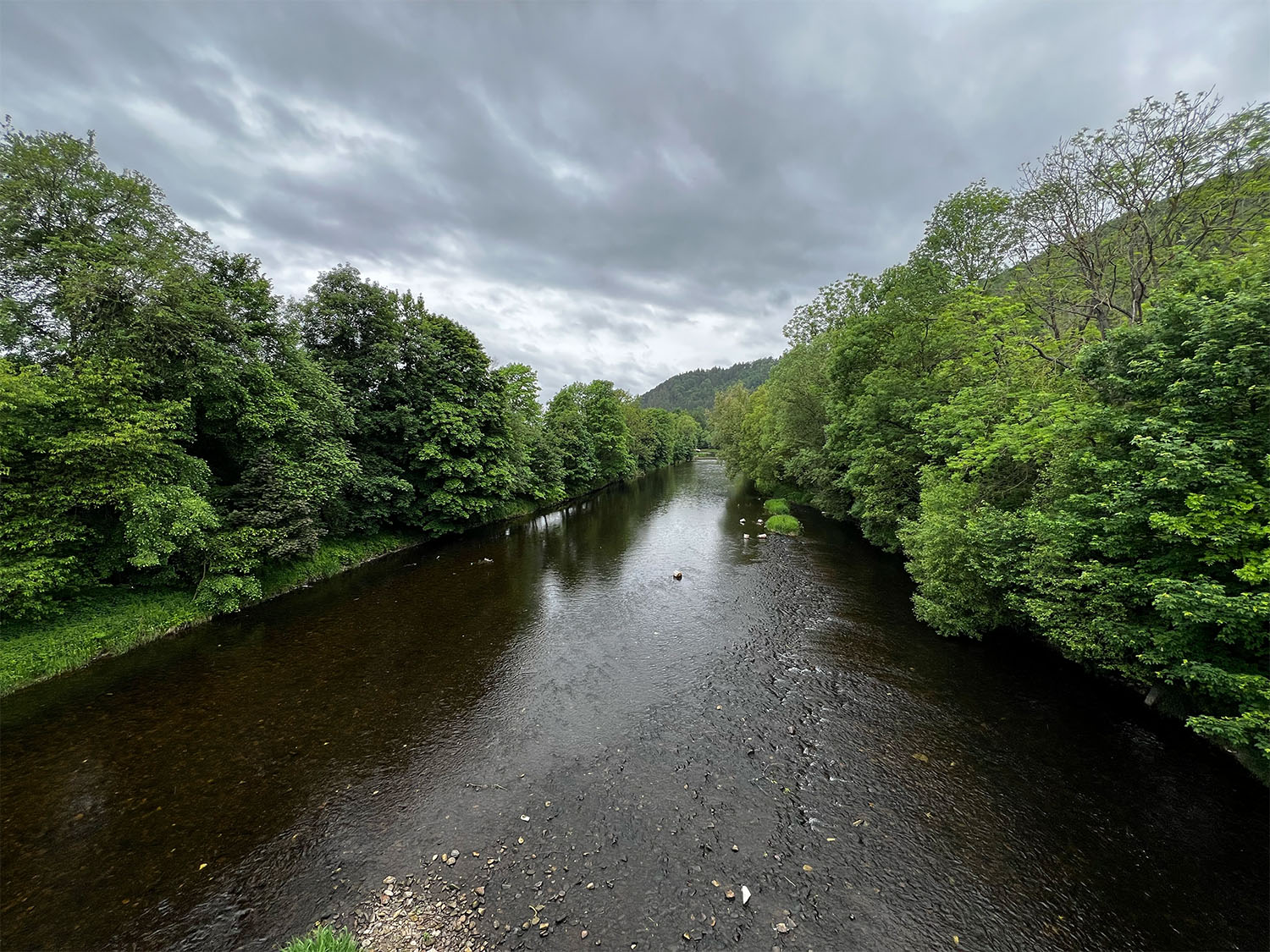
The bottom limit of my peg, the shallow riffle to the right and the long shallow flat above.
I started under the bridge in the riffle, early signs were bleak. One missed fish, then nothing. Eventually, I coaxed a wild brown to take a dry. Another was lost shortly after. Then, nothing. I had tried dries, dry-dropper and nymphs in what looked to be the best water.
Searching up the flat, I spotted a grayling. It rose for my dry, then slipped the hook at the net. That hurt. I was now 2 hours into my session and I had covered all of my water with very few chances or visible fish. I only had one choice.
Down to the bridge pool again. This time I went micro. A size 18 nymph, 0.10mm tippet. Just one rock breaking the current, half-hidden in the bridge’s shadow. The line stopped. Strike!
Chaos followed. The fish charged up and down the riffle completely out of control. I had to follow it to ensure it didn’t snag or rub off on a rock. A big rainbow launched into the air. Eight minutes later, I landed a 48cm fish! I couldn't believe a fish of this size was sitting in less than knee-deep water with no features, just the shadow of the bridge to provide cover.
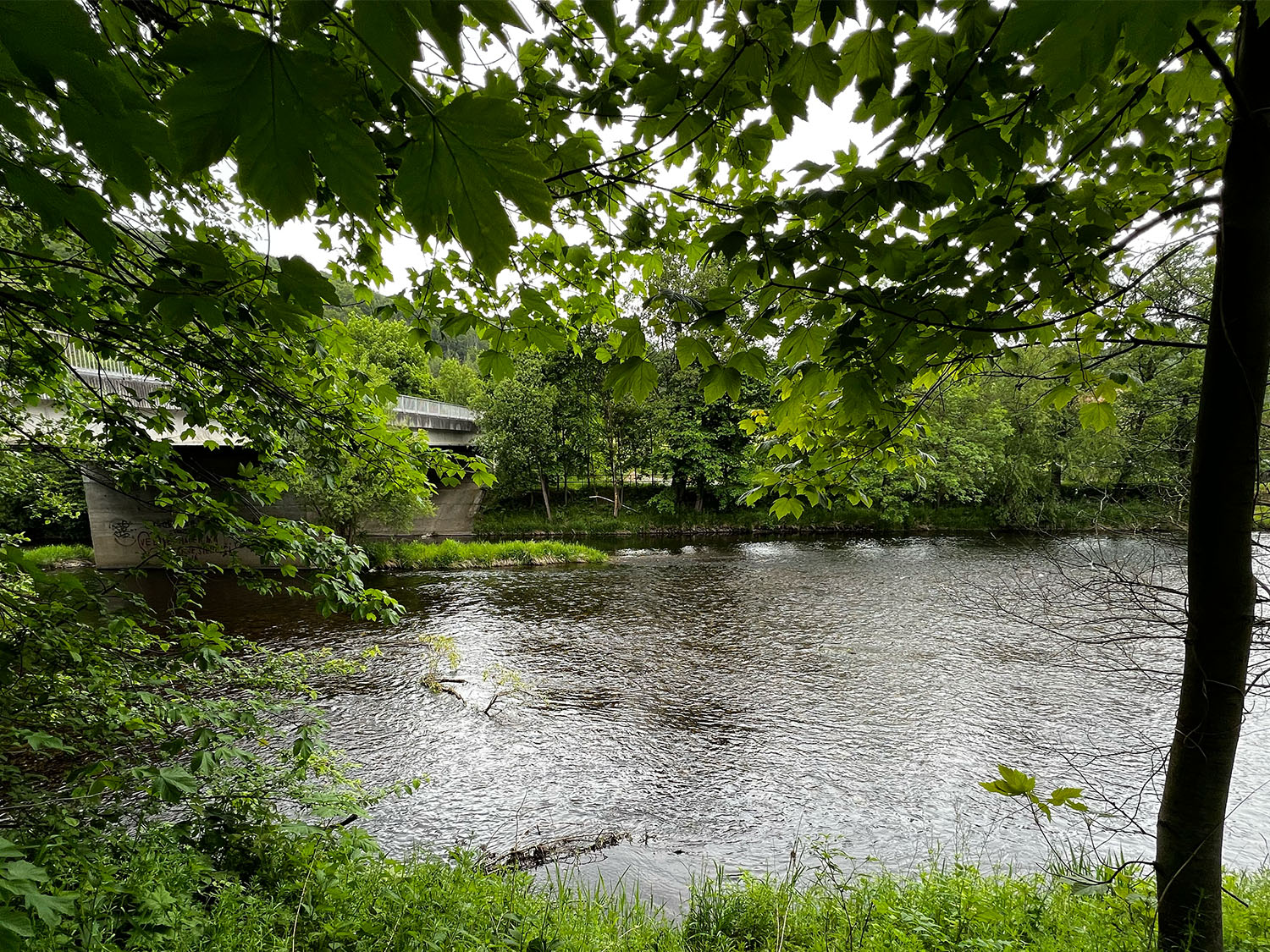
The lower limit, showing the section under the bridge
With that spot spooked from playing the last fish, I returned to the grayling. No takers. Then back again to the pool, fishing the same method as before – and again, the line stopped. This time it didn’t move, then the head shakes, this must be a bigger fish.
Ten more minutes of cat-and-mouse playing a large fish on very light gear. I waded loudly to keep it in the beat as it tried to run below the leg marker where I would for sure lose it. Finally, I slipped the net under a 67cm rainbow.
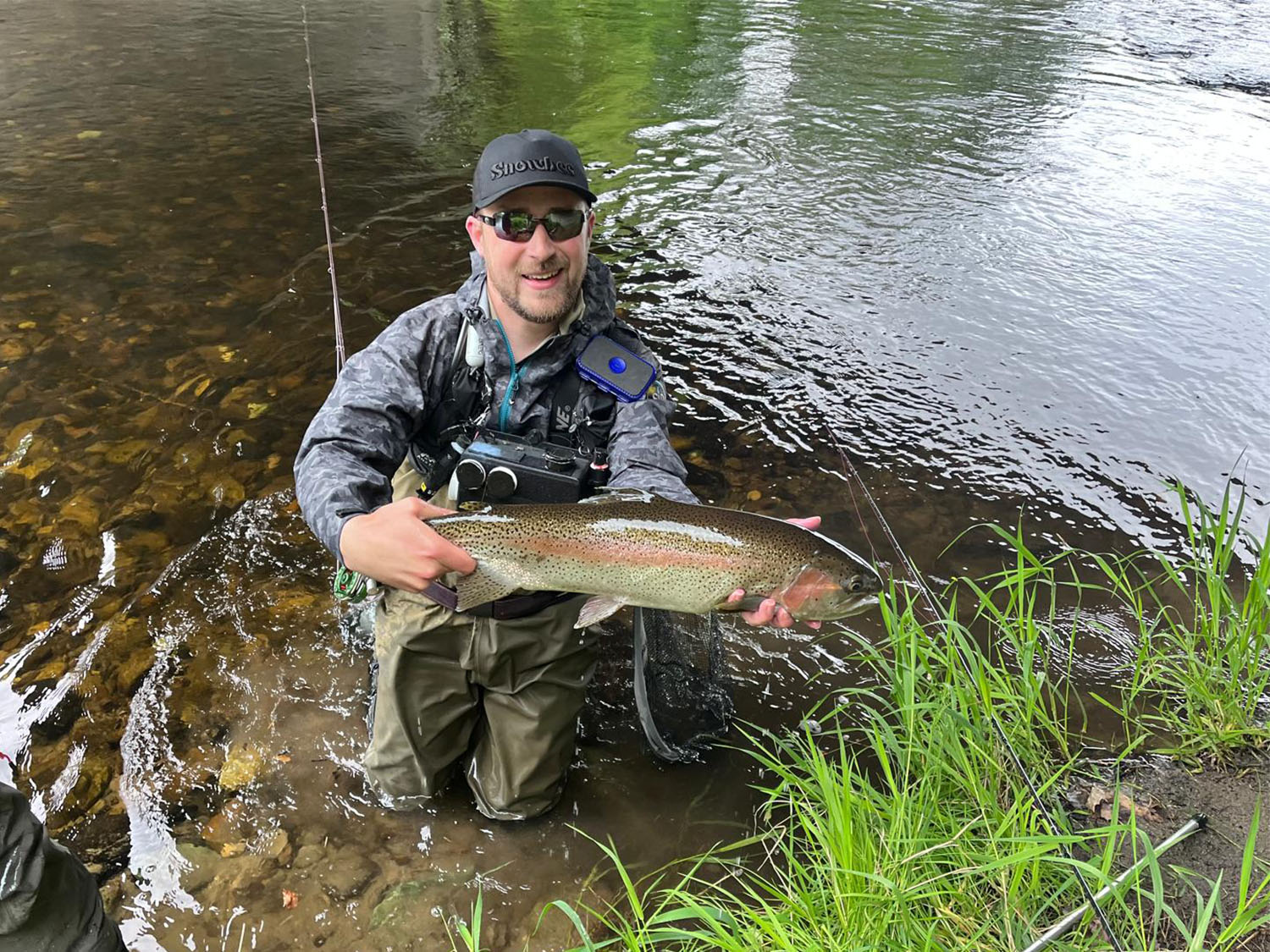
My 67cm rainbow and biggest fish from the river
I searched the flat for grayling again – nothing. I finished with just three fish. Crushed. Three fish would place me well down. Looking at the next peg – deep runs, islands, moving fish – rubbed salt into the wound. The team, though, had done well. We were still in the hunt, but the margin was shrinking.
Day 4: Lipno Lake - Boat
Lake day. Traditionally, one of our stronger areas. Plus, Sean Brooks had taken 2nd place on Day 1, so we had trust in our plan. I had control of the boat first and set our drift on the far bank. This avoiding the crowded top corner where most boats were converging.
We’d spotted fish moving here in practice. I started on a fast glass line with a Woofta booby on the point, a small cormorant in the middle, and a blob on the top dropper. A classic setup for stockies.
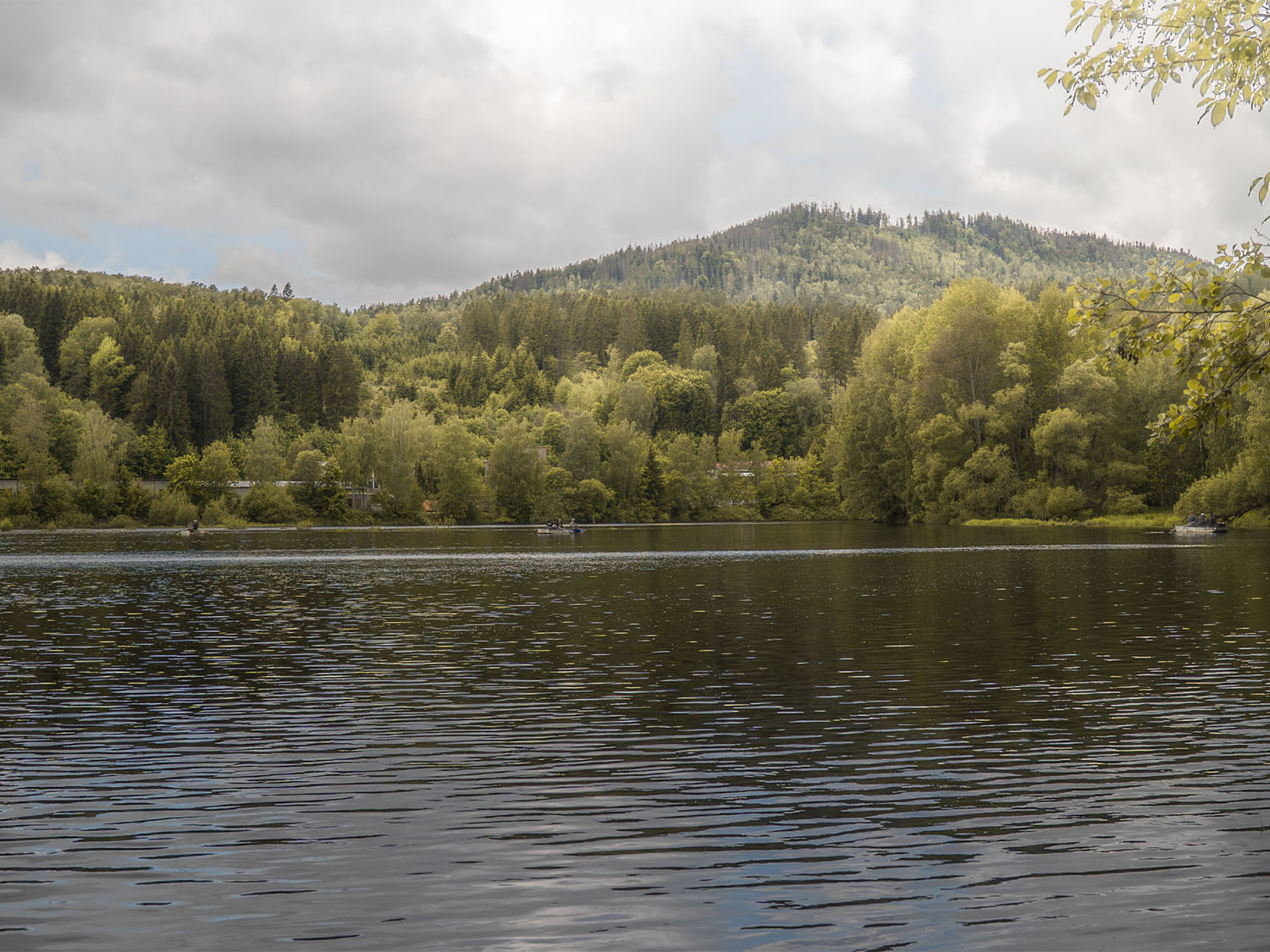
The lake looking up to the top corner, where most anglers fished
I had a fish early, which settled the nerves. As we drifted, pods of fish were visible, but frustratingly selective. They ignored most presentations until suddenly, one would eat.
After the first hour, I had two, but the catch rate wasn’t fast enough. We tried the busy top corner briefly, but the pressure was killing it. We drifted back along the far bank, which was faster in the growing wind. I switched to a faster sinking line and stripped fast – this got another quick reaction.
With five fish now landed, I pushed hard for a sixth, which came quickly, then hoped for a seventh. Right before the buzzer, I hooked two fish on the hang – but they ran in opposite directions and both broke off. Not how I wanted to finish.
My six fish were the smallest of the session, putting me in 7th rather than a likely 4th for the quantity landed. Not terrible, but not enough. Worse still, the other lads had drawn awful pegs on the rivers. We dropped from 3rd to 8th. A tough day.
Day 5: Devil Stones - Peg 8
The final day meant I was on The Devil Stones; my favourite river of the lot. Huge boulders, deep gullies, brown-tinged water and lots of fish.
My peg looked decent: three deeper pots and lots of smaller pockets. I started at the bottom, working through it with a single nymph, double nymph and duo. A fish rose early in the deep pot but refused every offering. After 20 minutes of changes and fine-tuning, I had just one roach and three missed takes.
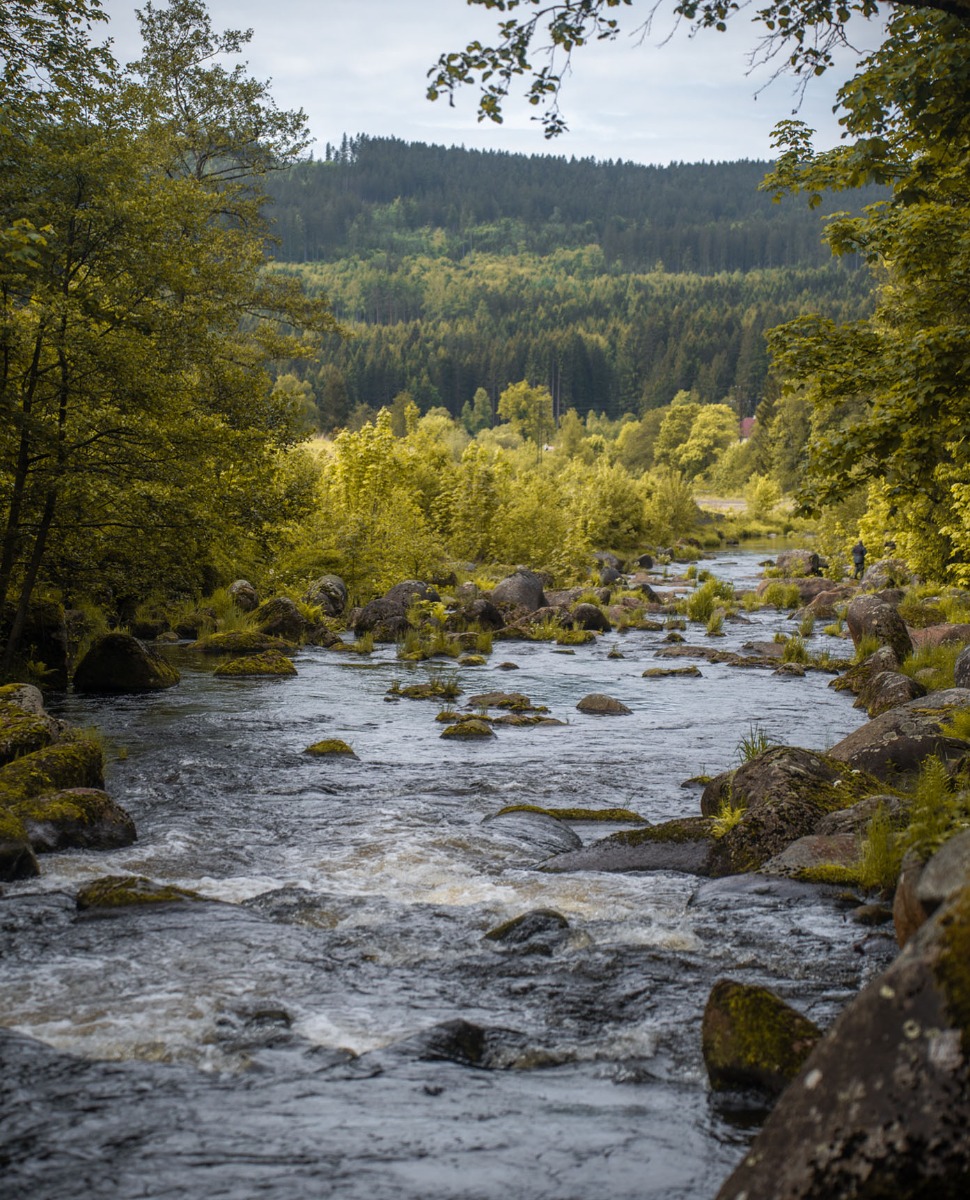
From the top of my peg looking downstream, it ran to where the long flat started
I worked every pocket hard, even dropping flies under big boulders. Nothing. Midway through, I had landed four fish. I poured everything into the biggest pot, again, nothing but undersized fish. Frustration mounted as I knew something was wrong, but I couldn't figure out what. I had changed flies, weights, presentations and still nothing.
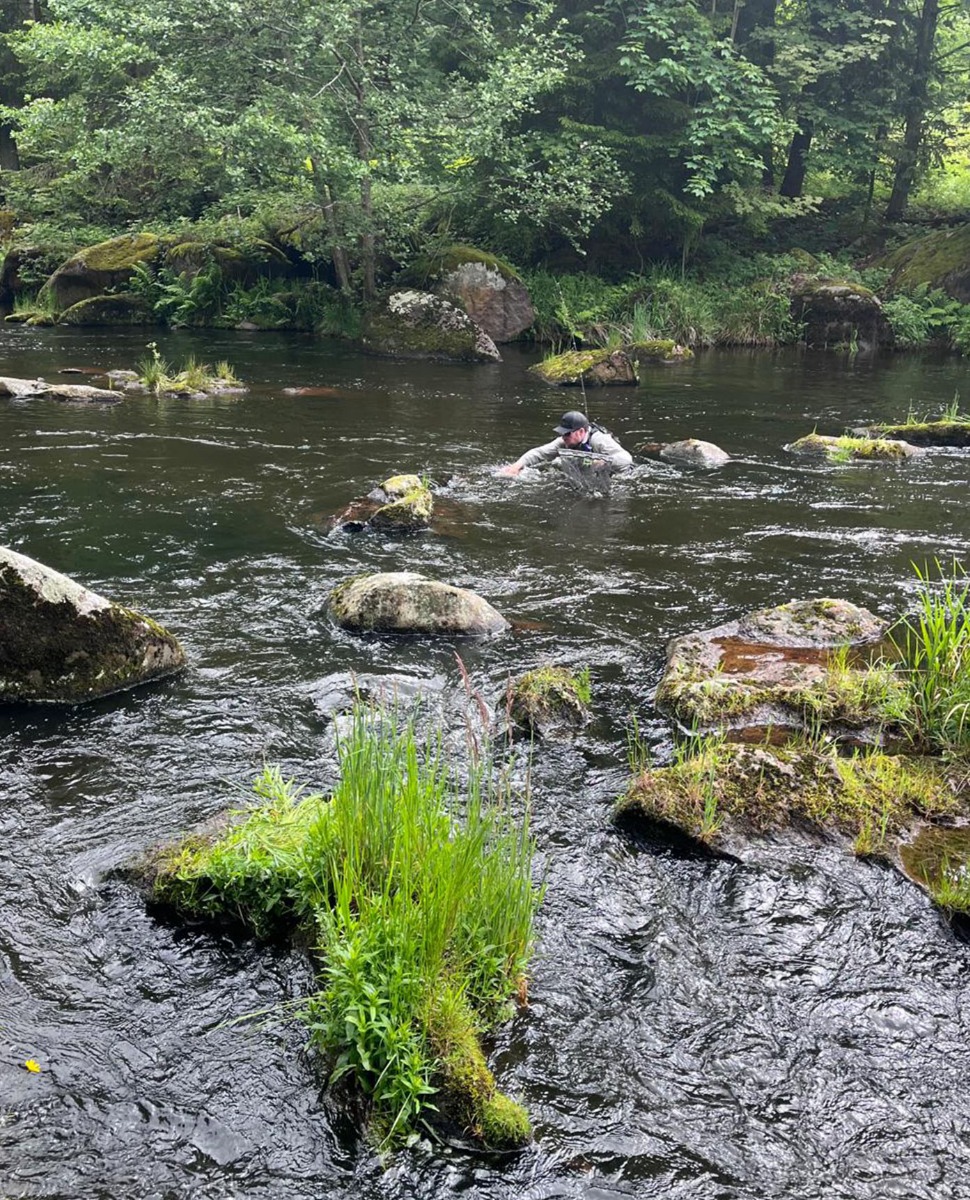
Wading back with a fish in the treacherous flow and large potholes.
A second pass of the bottom area got me two more fish, eight in total. Nowhere near enough. I needed 15+ to be in the game. I later reflected that I likely needed more weight and more fly animation. Perhaps even a bouncing dry approach. But at the time, I had no answers.
Closing Thoughts
As a team we finished in 6th place – close to 5th. Very respectable, but after holding medal position for so long, it felt gut-wrenching.
The closing ceremony was a quiet affair for us. So close, yet out of reach. A small consolation was that Scott Nellins took the biggest fish on the Vltava with an 80cm pike on a 3-weight. I took the biggest fish on the Otava with that 67cm rainbow, a small moment of pride.
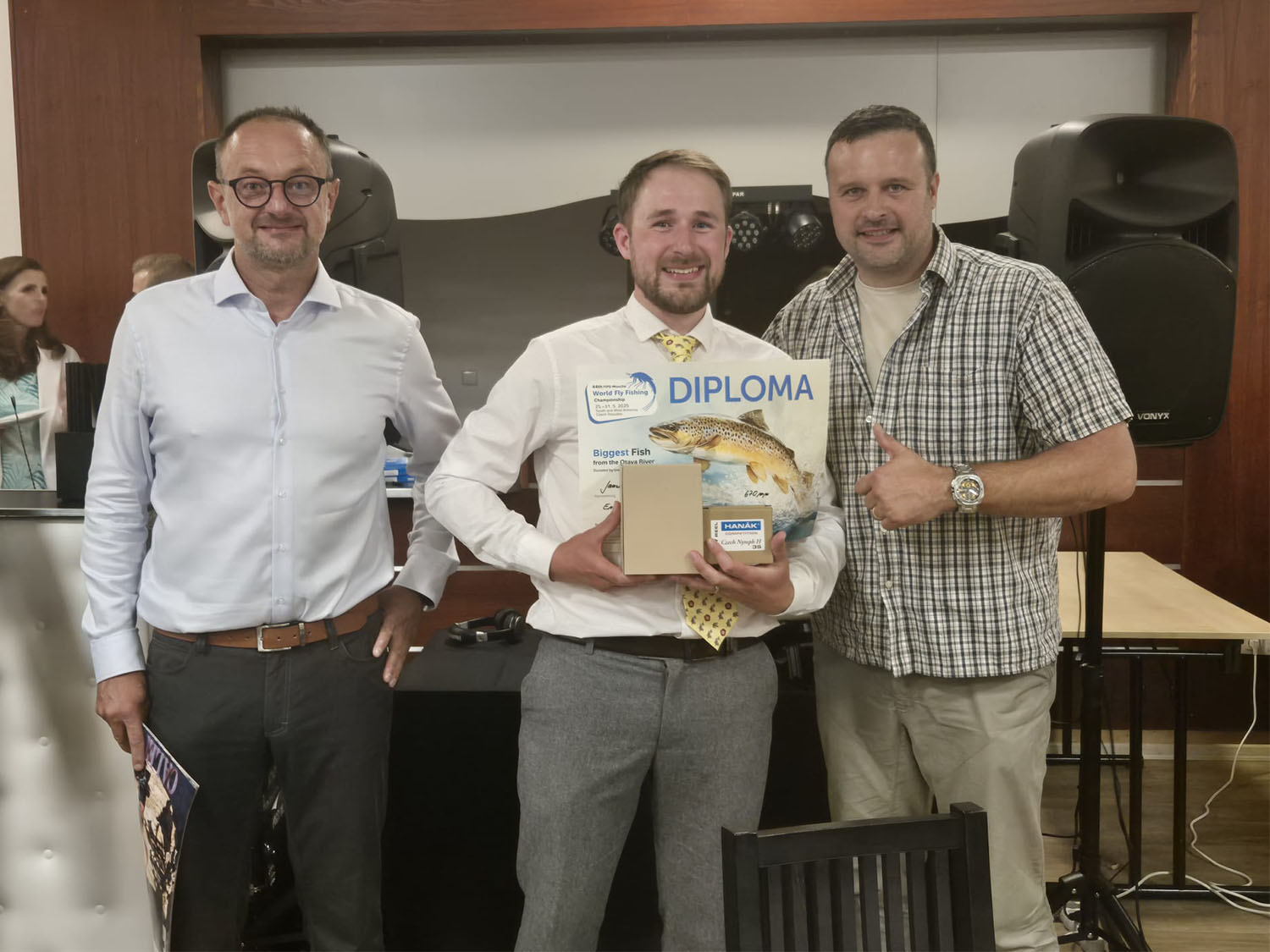
Receiving my prize for the biggest fish
The best part of the night came later on. Sharing beers and stories with anglers from around the world and reconnecting with friends – some of whom I’ve known since youth team days. That, more than medals, is the true reward.
Now, it’s straight into preparation for the EPP, the qualifiers for next year’s World Championships. Back to the tying desk, and already thinking about how to put the lessons learned this year into action.
James is one of our team of Snowbee ambassadors. He is a current England World Fly Fishing Team member (4x Caps), 2019 National Rivers Champion, England Elite Performance Program Champion 2021, 2nd place 2022, 2023 and 3rd 2024, with further 7 Senior and Youth international caps.
Featured Products
Elated from Day 1 and knowing we were in medal contention, nerves were running high on the bus to Rožmberk. The peg draw can feel agonising. When peg 25 was called for me, I checked the numbers. Nineteen fish had come off it the day before, resulting in 10th for the session. Not the best, but workable.

The bottom half of my peg, just as the pool tailed out into the riffles
The peg featured a deep hole at the bottom and a decent mid-beat riffle. Good water for holding stocked fish. I started with a DI3 line and two flies. A white streamer with green bead on the dropper and a black tadpole with an orange bead on the point. My best colours in practice.
The deep hole gave up nothing at first. I waded in, casting across and down, chest-deep in the cold water. As worry started to set in, the line went tight. Not one, but two fish on! One popped off quickly, leaving me to land the other. Relief.
I settled in, picking up fish steadily. One surprise was a 3lb barbel that I thought was the bottom until it started moving in the current.

Looking upstream into the deep pool and the top of my peg
Raft traffic was picking up, disrupting the water and my casting. Mark was again bankside, shouting guidance between flotillas. Sometimes I even hooked fish beneath rafts – chaotic but productive.

The top of my peg
With 20 minutes to go, I had landed 28 fish. I had a decision to make: rework the same water or target chub under the tree-lined far bank. I opted to re-fish the productive areas, changing to a more natural-looking streamer combo: olive and black with a copper bead. This proved spot-on, with four more fish, including one on the final cast.
That last fish was my favourite of the whole championship. Just after the one-minute call, a fish rose well upstream. I fired my back cast over it, stripped quickly and it exploded out of the water—fish on! We get five minutes’ grace to land a fish at the buzzer, and I made it count.

My 10ft 6wt Spectre pro playing the large stock fish well
Final tally: 32 fish. Giving me 3rd place in the session. The team remained in bronze medal position.
Day 3: Otava River – Peg 15
The Otava had not been kind to us. Brian did okay on a low beat, and Scott pulled out eight fish from what was essentially a canal! But now the weather had turned. Cold wind and rain killed off any surface activity.
The draw was done en-route again. I couldn't hear the draw so I had to ask Sean Jones from Wales who was right next to the sector judge, “14, mate” he said. Relief! A good peg.
Not quite. There was a mix-up – I actually drew peg 15. A beat that had fished poorly so far; whilst peg 14 was stockie heaven.
My water was crystal-clear and shallow. No depth, no cover, and hardly any features. The one promising area was a shallow run under a bridge. I planned to fish it carefully, then cover the margins with dries, and search the flats.

The bottom limit of my peg, the shallow riffle to the right and the long shallow flat above.
I started under the bridge in the riffle, early signs were bleak. One missed fish, then nothing. Eventually, I coaxed a wild brown to take a dry. Another was lost shortly after. Then, nothing. I had tried dries, dry-dropper and nymphs in what looked to be the best water.
Searching up the flat, I spotted a grayling. It rose for my dry, then slipped the hook at the net. That hurt. I was now 2 hours into my session and I had covered all of my water with very few chances or visible fish. I only had one choice.
Down to the bridge pool again. This time I went micro. A size 18 nymph, 0.10mm tippet. Just one rock breaking the current, half-hidden in the bridge’s shadow. The line stopped. Strike!
Chaos followed. The fish charged up and down the riffle completely out of control. I had to follow it to ensure it didn’t snag or rub off on a rock. A big rainbow launched into the air. Eight minutes later, I landed a 48cm fish! I couldn't believe a fish of this size was sitting in less than knee-deep water with no features, just the shadow of the bridge to provide cover.

The lower limit, showing the section under the bridge
With that spot spooked from playing the last fish, I returned to the grayling. No takers. Then back again to the pool, fishing the same method as before – and again, the line stopped. This time it didn’t move, then the head shakes, this must be a bigger fish.
Ten more minutes of cat-and-mouse playing a large fish on very light gear. I waded loudly to keep it in the beat as it tried to run below the leg marker where I would for sure lose it. Finally, I slipped the net under a 67cm rainbow.

My 67cm rainbow and biggest fish from the river
I searched the flat for grayling again – nothing. I finished with just three fish. Crushed. Three fish would place me well down. Looking at the next peg – deep runs, islands, moving fish – rubbed salt into the wound. The team, though, had done well. We were still in the hunt, but the margin was shrinking.
Day 4: Lipno Lake - Boat
Lake day. Traditionally, one of our stronger areas. Plus, Sean Brooks had taken 2nd place on Day 1, so we had trust in our plan. I had control of the boat first and set our drift on the far bank. This avoiding the crowded top corner where most boats were converging.
We’d spotted fish moving here in practice. I started on a fast glass line with a Woofta booby on the point, a small cormorant in the middle, and a blob on the top dropper. A classic setup for stockies.

The lake looking up to the top corner, where most anglers fished
I had a fish early, which settled the nerves. As we drifted, pods of fish were visible, but frustratingly selective. They ignored most presentations until suddenly, one would eat.
After the first hour, I had two, but the catch rate wasn’t fast enough. We tried the busy top corner briefly, but the pressure was killing it. We drifted back along the far bank, which was faster in the growing wind. I switched to a faster sinking line and stripped fast – this got another quick reaction.
With five fish now landed, I pushed hard for a sixth, which came quickly, then hoped for a seventh. Right before the buzzer, I hooked two fish on the hang – but they ran in opposite directions and both broke off. Not how I wanted to finish.
My six fish were the smallest of the session, putting me in 7th rather than a likely 4th for the quantity landed. Not terrible, but not enough. Worse still, the other lads had drawn awful pegs on the rivers. We dropped from 3rd to 8th. A tough day.
Day 5: Devil Stones - Peg 8
The final day meant I was on The Devil Stones; my favourite river of the lot. Huge boulders, deep gullies, brown-tinged water and lots of fish.
My peg looked decent: three deeper pots and lots of smaller pockets. I started at the bottom, working through it with a single nymph, double nymph and duo. A fish rose early in the deep pot but refused every offering. After 20 minutes of changes and fine-tuning, I had just one roach and three missed takes.

From the top of my peg looking downstream, it ran to where the long flat started
I worked every pocket hard, even dropping flies under big boulders. Nothing. Midway through, I had landed four fish. I poured everything into the biggest pot, again, nothing but undersized fish. Frustration mounted as I knew something was wrong, but I couldn't figure out what. I had changed flies, weights, presentations and still nothing.

Wading back with a fish in the treacherous flow and large potholes.
A second pass of the bottom area got me two more fish, eight in total. Nowhere near enough. I needed 15+ to be in the game. I later reflected that I likely needed more weight and more fly animation. Perhaps even a bouncing dry approach. But at the time, I had no answers.
Closing Thoughts
As a team we finished in 6th place – close to 5th. Very respectable, but after holding medal position for so long, it felt gut-wrenching.
The closing ceremony was a quiet affair for us. So close, yet out of reach. A small consolation was that Scott Nellins took the biggest fish on the Vltava with an 80cm pike on a 3-weight. I took the biggest fish on the Otava with that 67cm rainbow, a small moment of pride.

Receiving my prize for the biggest fish
The best part of the night came later on. Sharing beers and stories with anglers from around the world and reconnecting with friends – some of whom I’ve known since youth team days. That, more than medals, is the true reward.
Now, it’s straight into preparation for the EPP, the qualifiers for next year’s World Championships. Back to the tying desk, and already thinking about how to put the lessons learned this year into action.
James is one of our team of Snowbee ambassadors. He is a current England World Fly Fishing Team member (4x Caps), 2019 National Rivers Champion, England Elite Performance Program Champion 2021, 2nd place 2022, 2023 and 3rd 2024, with further 7 Senior and Youth international caps.

